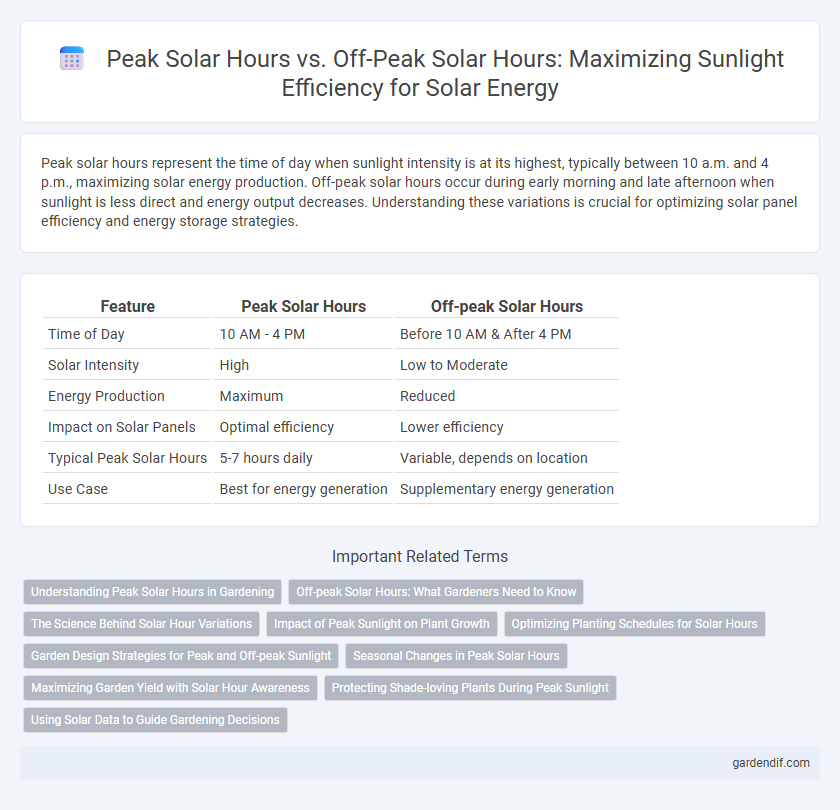
Peak Solar Hours vs Off-peak Solar Hours Illustration
Peak solar hours represent the time of day when sunlight intensity is at its highest, typically between 10 a.m. and 4 p.m., maximizing solar energy production. Off-peak solar hours occur during early morning and late afternoon when sunlight is less direct and energy output decreases. Understanding these variations is crucial for optimizing solar panel efficiency and energy storage strategies.
Table of Comparison
| Feature | Peak Solar Hours | Off-peak Solar Hours |
|---|---|---|
| Time of Day | 10 AM - 4 PM | Before 10 AM & After 4 PM |
| Solar Intensity | High | Low to Moderate |
| Energy Production | Maximum | Reduced |
| Impact on Solar Panels | Optimal efficiency | Lower efficiency |
| Typical Peak Solar Hours | 5-7 hours daily | Variable, depends on location |
| Use Case | Best for energy generation | Supplementary energy generation |
Understanding Peak Solar Hours in Gardening
Peak solar hours refer to the period during the day when sunlight intensity reaches its maximum, typically between 10 a.m. and 4 p.m., providing optimal energy for photosynthesis and plant growth. Understanding peak solar hours helps gardeners strategically position plants to maximize exposure to direct sunlight, improving flowering, fruiting, and overall plant health. Off-peak hours offer lower light intensity, suitable for shade-tolerant plants or seedling germination stages requiring less direct sunlight.
Off-peak Solar Hours: What Gardeners Need to Know
Off-peak solar hours refer to times of the day when sunlight intensity is lower, typically early morning and late afternoon, which affects photosynthesis rates in plants. Gardeners should optimize watering and fertilization during off-peak hours to reduce evaporation and maximize nutrient absorption. Understanding off-peak solar hours helps in scheduling tasks like planting shade-loving species and minimizing heat stress on sensitive plants.
The Science Behind Solar Hour Variations
Peak solar hours occur when the sun is at its highest point, typically between 10 a.m. and 4 p.m., resulting in maximum solar irradiance and optimal energy generation. Off-peak solar hours, found in the early morning and late afternoon, produce lower solar irradiance due to the sun's angle and atmospheric scattering. These variations arise from Earth's rotation, axial tilt, and atmospheric conditions, which influence the intensity and duration of sunlight reaching solar panels.
Impact of Peak Sunlight on Plant Growth
Peak solar hours, typically occurring between 10 a.m. and 4 p.m., provide intense sunlight crucial for maximizing photosynthesis and accelerating plant growth. During these hours, the high light intensity optimizes chlorophyll activity, enhancing nutrient absorption and energy production in plants. Off-peak solar hours offer reduced light intensity, resulting in slower photosynthetic rates and less efficient growth compared to peak sunlight exposure.
Optimizing Planting Schedules for Solar Hours
Peak solar hours, typically occurring midday when sunlight intensity is highest, provide the maximum energy for photosynthesis, making them crucial for scheduling planting times in solar-dependent crops. Off-peak solar hours offer reduced light intensity but contribute to overall daily sunlight exposure, which supports continued plant growth and development. Optimizing planting schedules by aligning critical growth stages with peak solar hours enhances plant productivity and maximizes energy utilization for photosynthetic efficiency.
Garden Design Strategies for Peak and Off-peak Sunlight
Garden design strategies maximize plant growth by utilizing peak solar hours, which typically provide 5 to 7 hours of intense sunlight essential for sun-loving plants such as tomatoes, sunflowers, and lavender. Off-peak solar hours, characterized by lower light intensity during early morning and late afternoon, favor shade-tolerant species like ferns and hostas, promoting biodiversity and microclimate balance. Incorporating plant placement based on solar hour data optimizes photosynthesis, enhances energy efficiency, and sustains seasonal garden health.
Seasonal Changes in Peak Solar Hours
Peak solar hours vary significantly with seasonal changes, reaching their maximum during summer months when the sun remains higher in the sky for extended periods. During winter, off-peak solar hours increase as sunlight intensity diminishes and daylight hours shorten, reducing overall solar energy capture. Understanding these variations helps optimize solar panel performance and energy storage by aligning system usage with fluctuating solar irradiance patterns throughout the year.
Maximizing Garden Yield with Solar Hour Awareness
Maximizing garden yield requires understanding peak solar hours, typically between 10 a.m. and 4 p.m., when sunlight intensity is highest, enabling plants to photosynthesize efficiently. Off-peak solar hours provide lower light intensity, which may support shade-tolerant plants or reduce water evaporation. Optimizing garden layout based on solar hour data enhances plant growth, water use, and overall productivity.
Protecting Shade-loving Plants During Peak Sunlight
Peak solar hours deliver intense sunlight crucial for maximizing photosynthesis but can damage shade-loving plants susceptible to leaf scorch and dehydration. Off-peak solar hours provide gentler light conditions, enabling these plants to thrive without stress from excessive UV exposure. Strategically placing shade-loving species in shaded areas or using protective coverings during peak hours enhances plant health and prevents damage.
Using Solar Data to Guide Gardening Decisions
Peak solar hours provide valuable data on the most intense sunlight periods, essential for selecting sun-loving plants that require maximum photosynthesis for growth. Off-peak solar hours offer insights into lower light availability, guiding gardeners to choose shade-tolerant or low-light plants that thrive during these times. Utilizing detailed solar intensity data ensures optimized plant placement and irrigation scheduling, enhancing overall garden productivity.
Peak Solar Hours vs Off-peak Solar Hours Infographic

 gardendif.com
gardendif.com